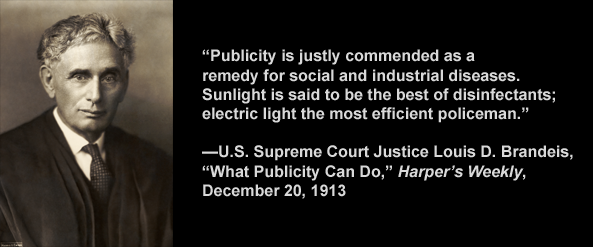(Page 1 of 3)

U.S. Supreme Court Justice Louis D. Brandeis, in the public domain. (Photo credit: Harris & Ewing Collection at the Library of Congress, Prints & Photographs Division, circa 1916)
Nursing homes misappropriated $1.5 billion from taxpayer-funded Medicare in 2009, says new HHS inspector general study
Wealthy, highly profitable nursing homes in California and throughout the United States often cry poor, claiming that taxpayer-funded Medicare and Medicaid payments to facilities are not enough to ensure that they comply with laws regarding staffing and quality of care. But a new study released this month by U.S. Department of Health and Human Services’ (HHS) Office of Inspector General (OIG) says that nursing homes ripped off $1.5 billion from U.S. taxpayers in just 2009 alone by submitting “inaccurate, medically unnecessary, and fraudulent claims” to Medicare.
HHS inspector general’s report is part of larger study of nursing homes’ ongoing Medicare fraud and deficient care
OIG’s new report, the November 2012 Inappropriate Payments to Skilled Nursing Facilities Cost Medicare More than a Billion Dollars in 2009 (OEI-02-09-00200), is the second part in OIG’s series of studies on nursing homes’ ongoing Medicare fraud, rip-off of the U.S. taxpayer, and poor quality of care.
The first part in OIG’s series of studies, the December 2010 Questionable Billing in Skilled Nursing Facilities (OEI-02-09-00202), found that from 2006 to 2008:
- Nursing homes, also known as skilled nursing facilities (SNFs), significantly increased billing for “ultrahigh therapy,” which is the highest and most expensive of five levels of physical, occupational, or speech therapy used to determine patients’ care and resource needs and, therefore, Medicare payments to SNFs.
- SNFs significantly increased billing for higher levels of assistance with activities of daily living (ADLs).
- SNFs billed Medicare at the higher, more profitable levels of therapy and assistance with ADLs, even though patients’ care and resource needs remained about the same.
- For-profit SNFs, especially those owned by large chains, were much more likely than nonprofit or government SNFs to “upcode,” i.e., wrongfully bill Medicare for higher and more expensive levels of therapy and assistance with ADLs.
OIG’s forthcoming study Medicare Requirements for Quality of Care in Skilled Nursing Facilities (OEI-02-09-00201) will examine the degree to which SNFs, which must be in “substantial compliance” with federal quality-of-care laws to receive Medicare payments, actually meet these federal requirements.
Although HHS-OIG’s reports did not name nursing homes, Washington Post said OIG was investigating North American Health Care Inc. for alleged Medicare “upcoding”
Although the Office of Inspector General did not name specific nursing home owners in its 2010 and 2012 studies on nursing homes’ major Medicare fraud, The Washington Post named two nursing home chains in a March 2010 article about OIG’s 2010 study. Besides mentioning Toledo, Ohio-based HCR ManorCare, the March 29, 2010 Washington Post article “Review Heightens Concerns over Medicare Billing,” by Scott Higham and Dan Keating, said that “a separate division” of OIG was investigating Dana Point, California-based North American Health Care Inc. (NAHC), which operates 35 facilities. According to The Post, Service Employees International Union (SEIU), which had been in a union-organizing dispute with NAHC, discovered a “pattern” of Medicare “upcoding” by NAHC. “The SEIU gave results of its NAHC examination to Rep. Pete Stark (D-Calif.), who chairs a House Ways and Means subcommittee that oversees Medicare,” said The Post. “In September, Stark asked the HHS inspector general to investigate, alleging that NAHC ‘may have overbilled Medicare more than $180 million through a system-wide pattern of ‘upcoding.’’”
The Washington Post said that its own analysis of SEIU data on North American Health Care’s Medicare billing “confirmed” SEIU’s and Representative Stark’s “upcoding” allegations. The March 29, 2010 article in The Post said:
- “The Post independently analyzed an updated version of the data and confirmed the pattern.”
- “The Post also found that NAHC operated 21 of the top 30 facilities nationally with the highest percentage of residents billed in the most expensive category.”
- “Across the chain, 64 percent of NAHC patients are billed in the highest category; the national average is 9 percent.”
- “The category covers the most extensive medical care combined with the most intensive rehabilitation.”
John L. Sorensen, North American Health Care’s president and chief executive, responded to “upcoding” allegations in Washington Post
Responding to these serious allegations of Medicare “upcoding,” John L. Sorensen, NAHC’s president and chief executive, said that he was “cooperating with the HHS inspector general’s investigation,” The Washington Post reported. Sorensen explained, according to The Post, that “residents in the highest category are recovering from major surgeries and need specialized care.” But The Post, which did not have access to specific medical records to confirm SEIU’s analysis, said the union’s analysis of the records showed that “NAHC’s residents were no sicker or in greater need of therapy than other nursing home residents.” Sorensen told The Post, “We have honest and forthright business practices in place. . . . We don’t have any need or reason to be doing any kind of upcoding. That would be completely wrong.”
SEIU’s publication of “upcoding” allegations against North American Health Care coincided with Washington Post’s exposé
When The Washington Post published its March 29, 2010 exposé on the OIG’s investigation of North American Health Care, SEIU published the following about its Medicare “upcoding” allegations against North American Health Care:
- SEIU’s March 29, 2010 press release “Major California Nursing Home Chain Allegedly Falsified Records, Overbilled Medicare $100 Million”
- SEIU’s March 30, 2010 “The Largest Medicare Fraud Ever in the Nursing Home Industry?” by Kate Thomas
- SEIU’s webpage entitled “North American Health Care (NAHC) May Be Falsifying Patient Records and Overcharging Medicare by Tens of Millions of Dollars a Year in What Could Be the Largest Nursing Home Fraud Ever”
Continue to page 2…


